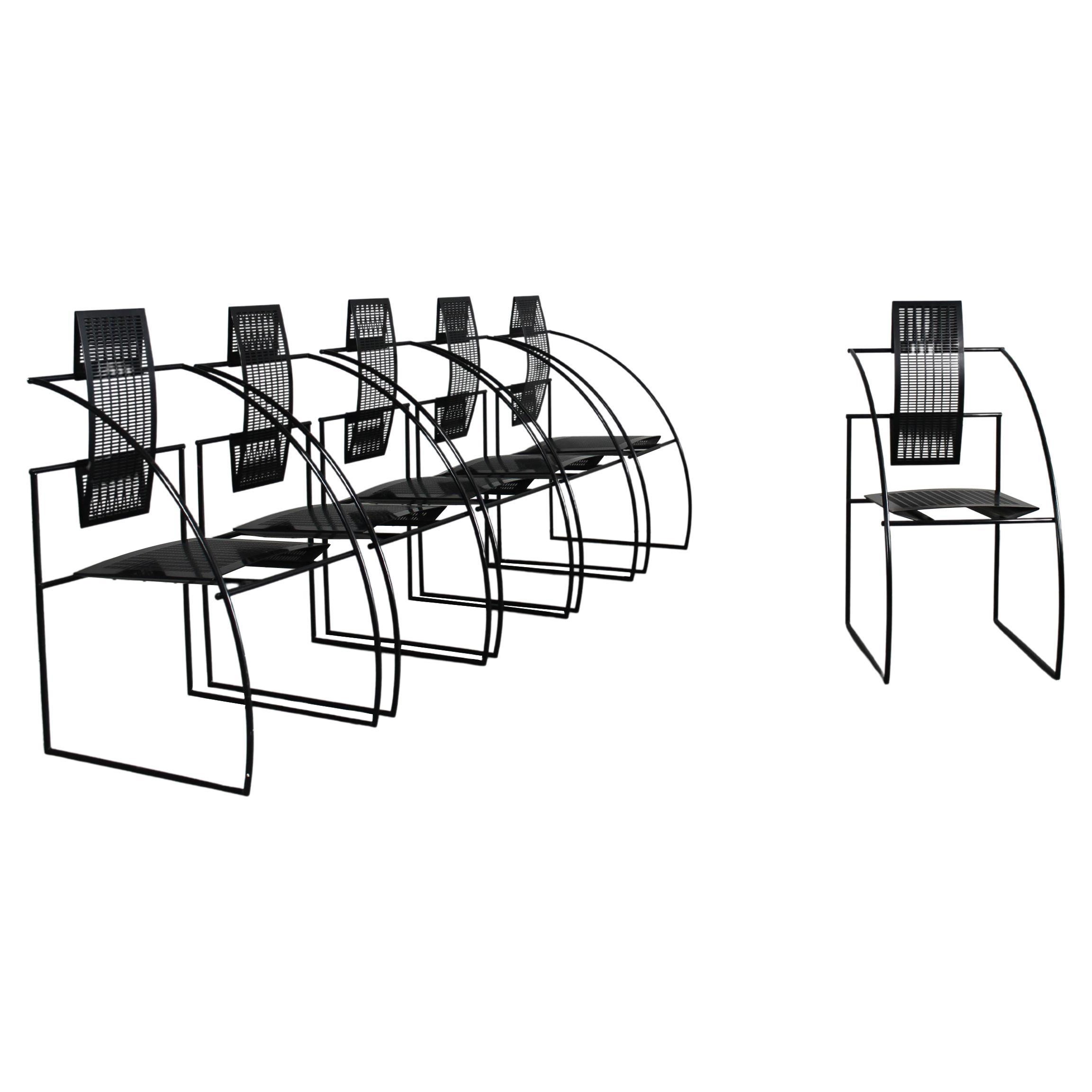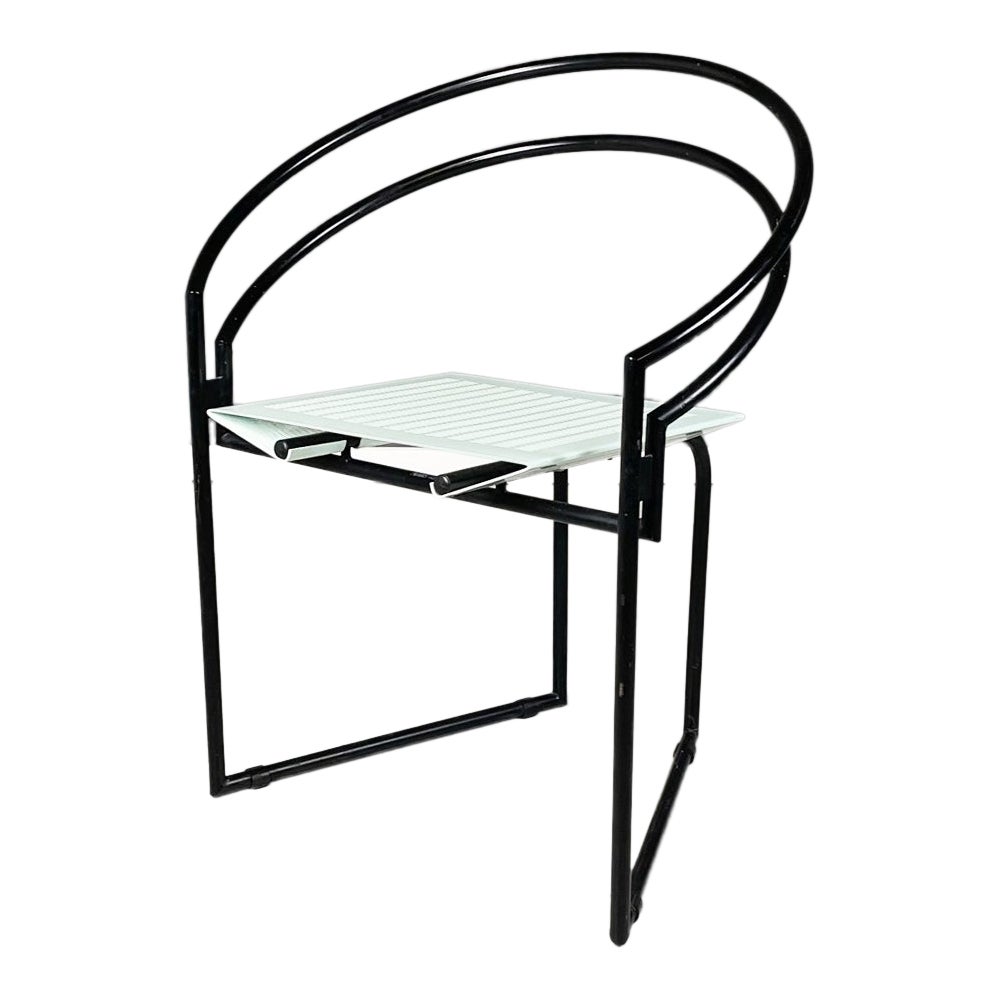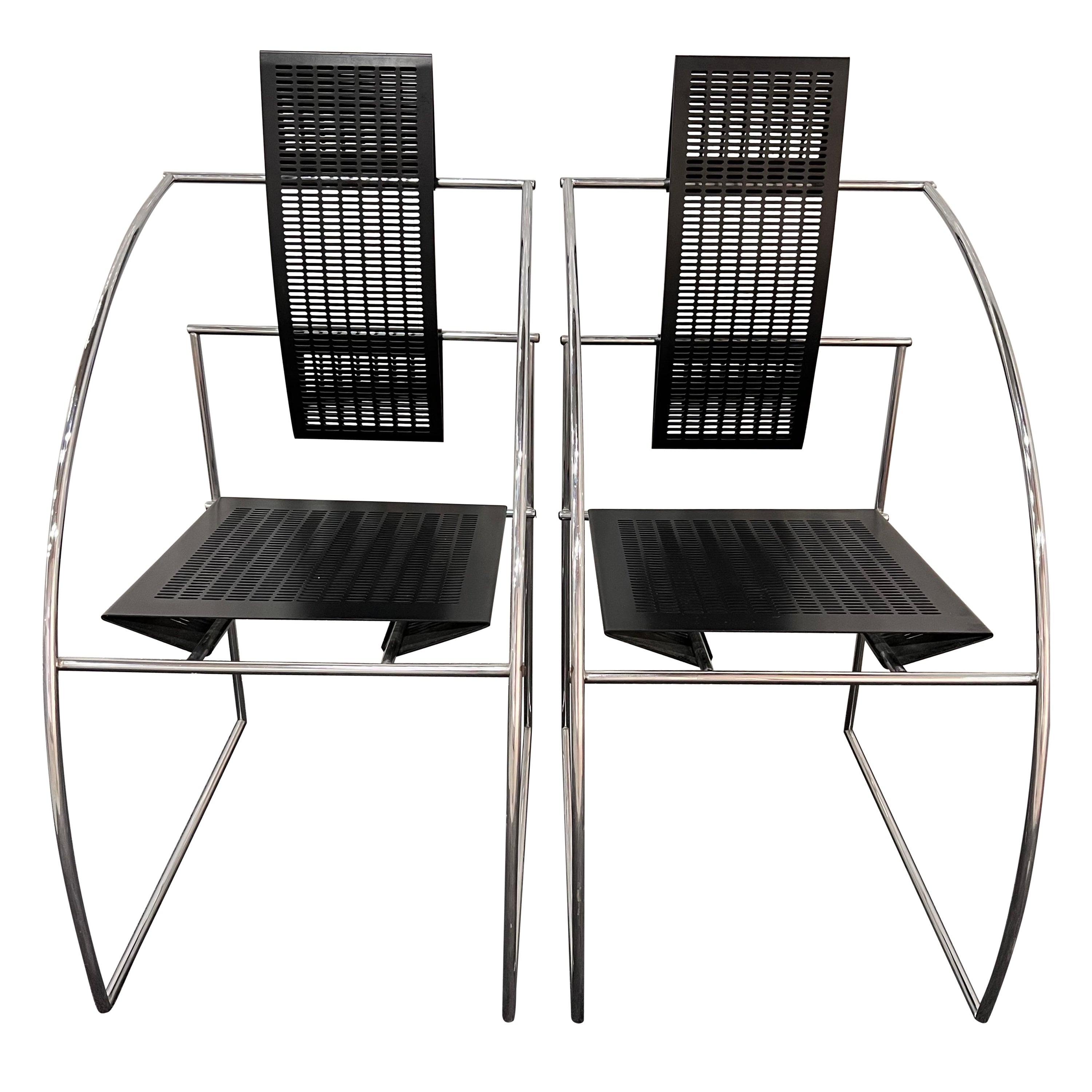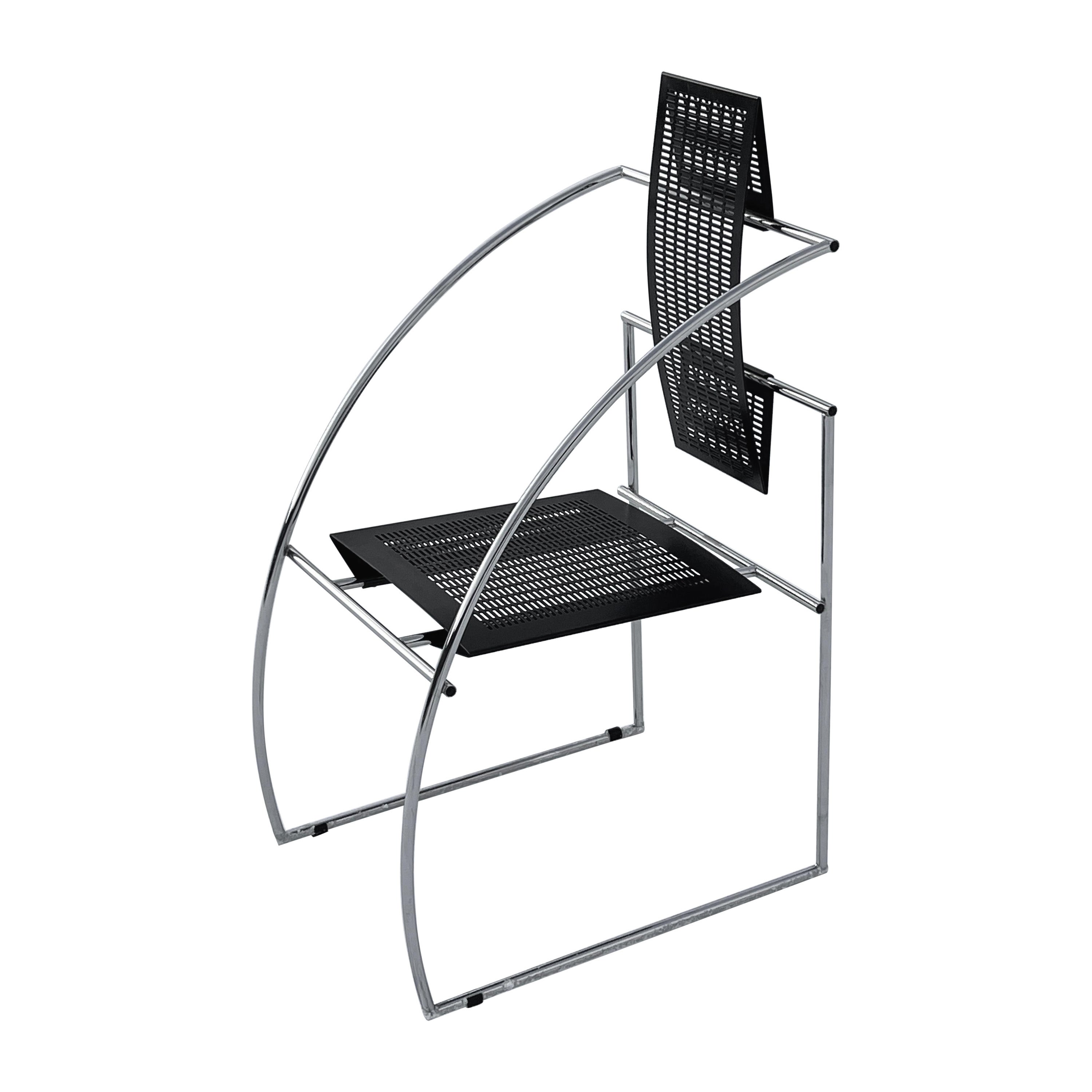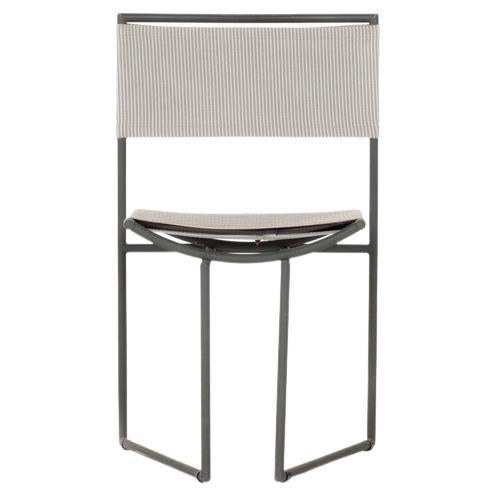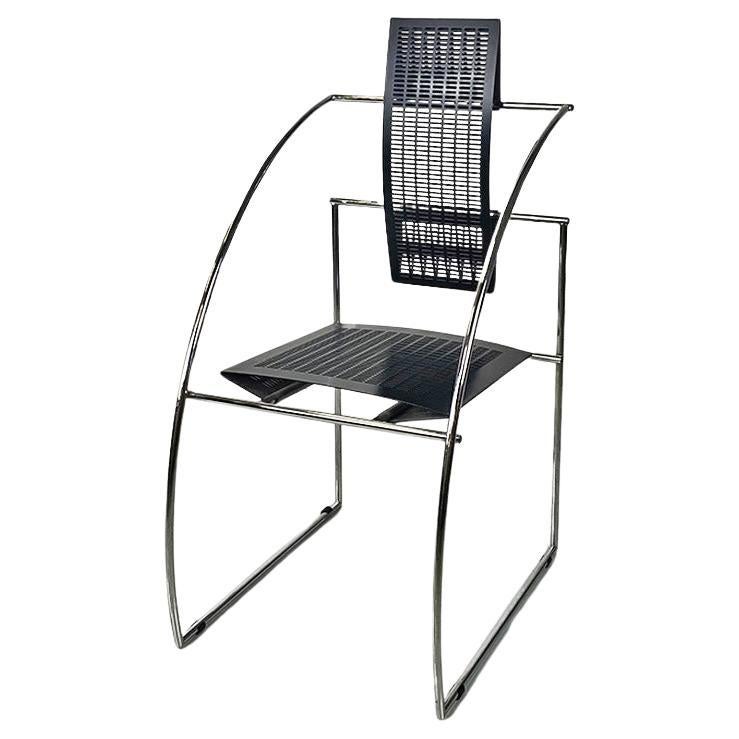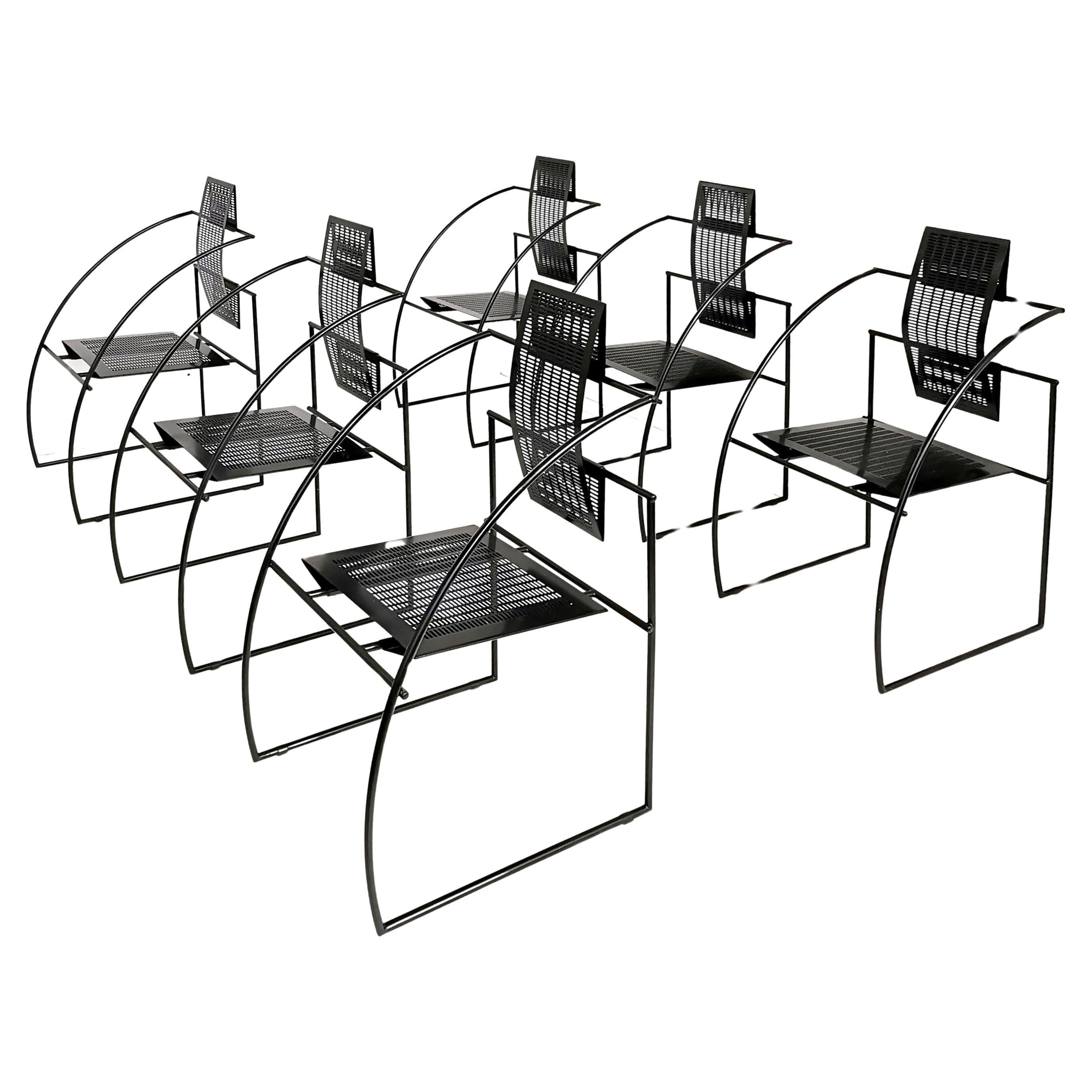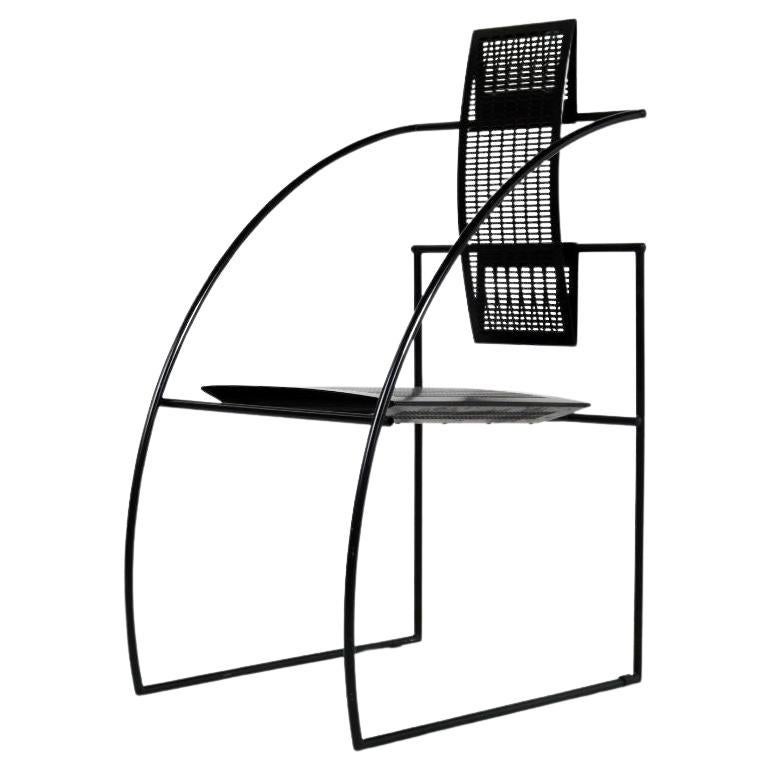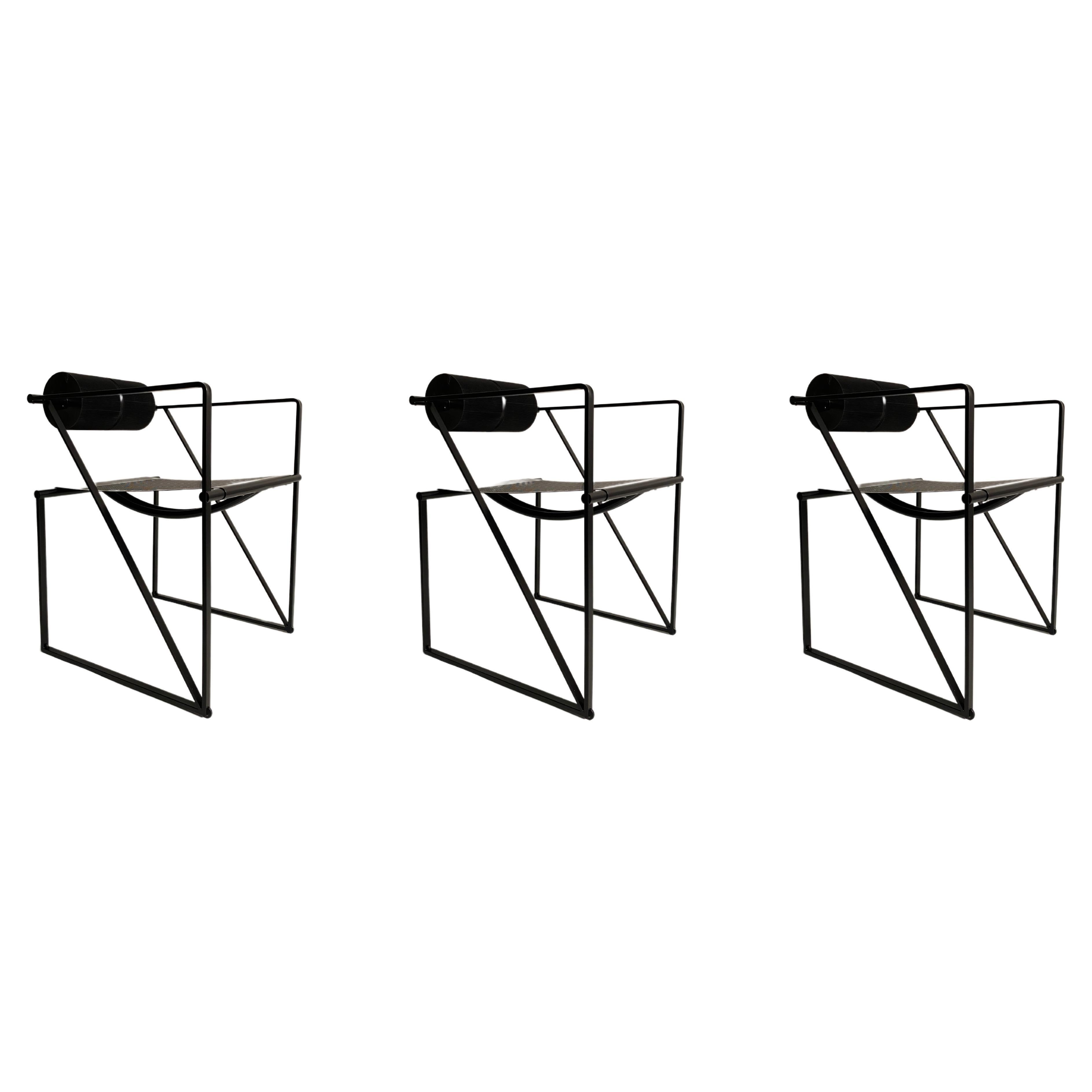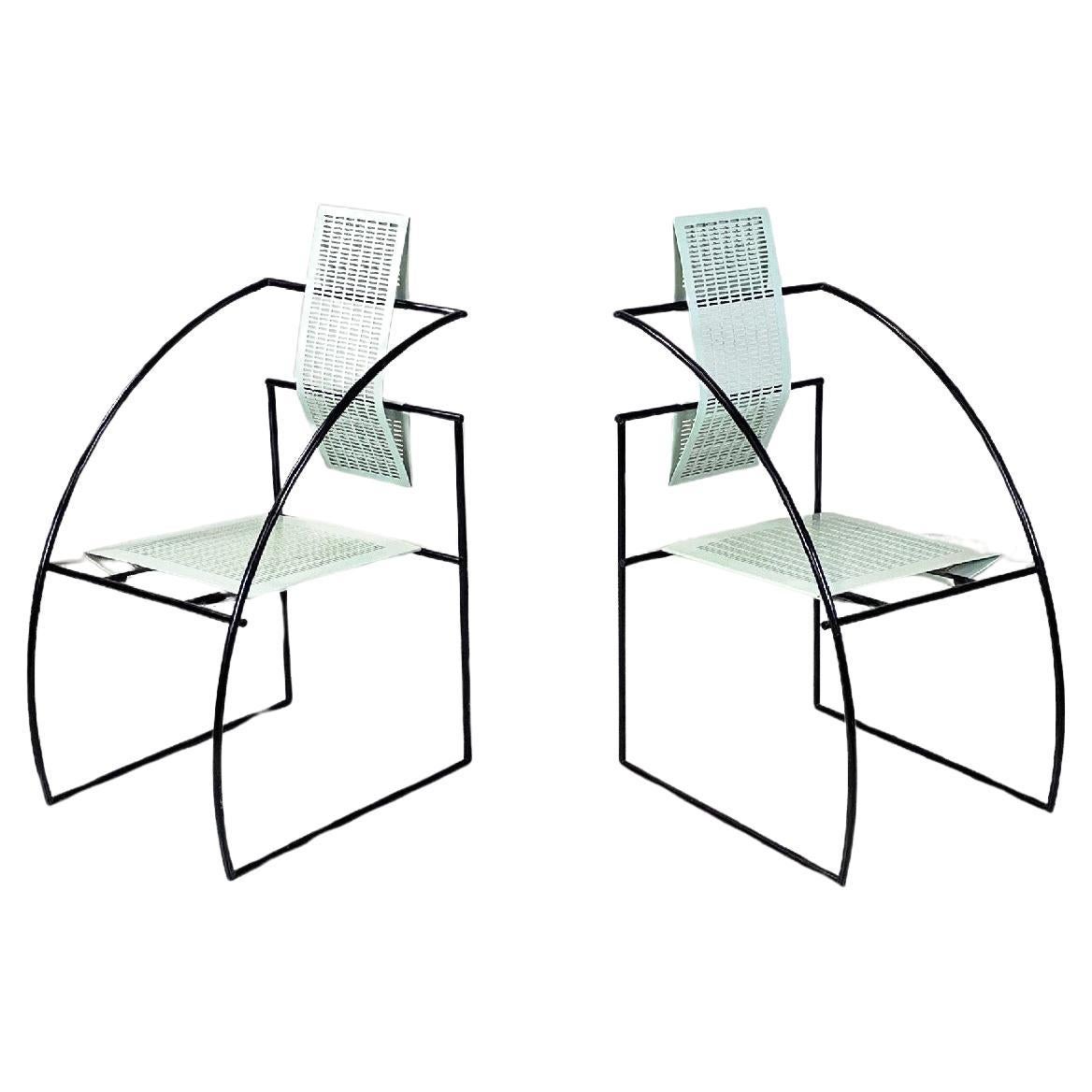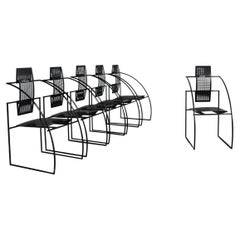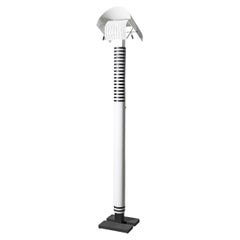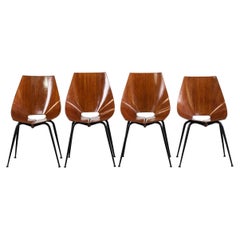
Mario Botta Set of Four 614 or La Tonda Chairs in Black Lacquered Steel by Alias
View Similar Items
Mario Botta Set of Four 614 or La Tonda Chairs in Black Lacquered Steel by Alias
About the Item
- Creator:Alias (Manufacturer),Mario Botta (Designer)
- Dimensions:Height: 29.93 in (76 cm)Width: 25.2 in (64 cm)Depth: 18.9 in (48 cm)
- Sold As:Set of 4
- Style:Post-Modern (Of the Period)
- Materials and Techniques:
- Place of Origin:
- Period:1980-1989
- Date of Manufacture:1980s
- Condition:
- Seller Location:Montecatini Terme, IT
- Reference Number:1stDibs: LU5304231109992
Mario Botta
Swiss architect Mario Botta may be renowned for his impressive postmodern architecture projects such as the San Francisco Museum of Modern Art, but the chairs, lighting and other furniture he created reflect a mastery of geometrically rich forms and an elegant application of simple symmetry.
Born in Mendrisio, Switzerland, in 1943, Botta gained an interest in architecture at an early age. He apprenticed at the architectural firm Carloni and Camenisch and designed his first building — a two-family house at Morbis Superiore in Ticino — at age 16. During the early 1960s, Botta attended the Liceo Artistico in Milan and then studied at the University Institute of Architecture in Venice under art historian Giuseppe Mazzariol and influential Italian architect Carlo Scarpa.
While studying in Venice, Botta worked for Swiss-born French architect Le Corbusier — whose career spanned hundreds of architecture projects — and gained inspiration from Estonian-American architect Louis Kahn, who was known for his modern and brutalist architectural style. In 1969, Botta completed his studies and established his practice in Lugano, designing and building single-family homes.
Throughout the 1970s, Botta gained fame for his innovative, geometrical designs and deceptively simple forms, such as his first large-scale building project in 1977 — the Middle School in Morbio Inferiore, Switzerland. Botta later established himself as one of the masters of 1980s postmodern design in his architecture and his furniture. His postmodern ideas characterize the dining room tables and seating he designed for companies such as Alias, as well as his table lamps and floor lamps for Artemide.
Botta’s noteworthy architectural projects designed during the 1990s and 2000s include the Cymbalista Synagogue and Jewish Heritage Center in Tel Aviv, Israel; the Monastery of the Holy Apostles Saint Peter and Andrew in Lviv, Ukraine; and the Theater of Architecture in Mendrisio, in 2018.
On 1stDibs, discover a range of vintage Mario Botta lighting fixtures, seating, tables and decorative objects.
- Mario Botta Set of Six 605 Quinta Chairs in Black Lacquered Steel by Alias 1980By Alias, Mario BottaLocated in Montecatini Terme, ITSet of six 605 Quinta chairs with a black steel rod frame seat and back in bent perforated sheet metal. Designed by Mario Botta for Alias in 1985 (This chair is no longer in production). The Quinta chair it's an architecture you can sit on, this design clearly shows the inspiration of iconic designer as Le Corbusier, Louis Kahn, and Carlo Scarpa, an exemplary of this iconic chair is also exhibited at the Museum of Modern Art. Mario Botta was born in 1943 in Mendrisio. After working as an apprentice draughtsman for the Lugano-based architect Tita Carloni, he moved first to Milan and then to Venice, where he enrolled at the department of Architecture at the IUAV. He completed his degree in 1969 with a thesis tutored by Carlo Scarpa – after having met Le Corbusier and Louis Kahn, who were later to be sources of inspiration – and returned to Switzerland to open his own professional firm, which at the time dealt mainly with detached family private homes. These included the villas in Riva San Vitale (1971-1973), Ligornetto (1975-1976) and Morbio Superiore (1982-1983), in which Botta treated the theme of the home as a refuge, which protects and reassures its inhabitants. These were buildings with a character that was ironic and, in a certain sense, monumental, obtained for example (in the case of Morbio) through rigorous symmetrical compositions and a particular use of raw concrete blocks set in a linear pattern and alternated with strips of silvered brick which, on the contrary, were set at 45 degrees. Partially dug into the hillside, the villa was also characterised by a theme which was particularly dear to Botta and which had already been explored in Riva San Vitale; the net distinction between solids and voids, the latter appearing to have been dug out of the building. Between 1980 and 1990, Botta associated with artists and intellectuals from all walks of life and took numerous long trips abroad. Together with Gabriele Basilico and Edoardo Sanguinetti, he published “La Casa Rotonda”, and he became friends with Max Huber, Nicki de Saint Phalle, Dante Isella, Harld Szeemann, Robert Frank and Alberto Flammer. In 1986, the MoMA in New York dedicated a solo exhibition to his work, and the Swiss architect received his first contracts for public buildings and from abroad, debuting with the Cultural Centre in Chambéry (1984-1987). In Japan, on a challenging triangular lot of only one hundred and sixty square metres, a space which remained from the opening of a new highway, Botta built a small building which, with its clarity and strength of image, attempted to stand out in the midst of the chaos that surrounded it, thanks to a thick masonry curtain raised on the main façade, in which slabs of grey marble are crossed with horizontal fissures which erode the angles and cancel the perception of the number of floors which make up the museum. The church of Mongo, on the other hand, was the first step in a long series of places of worship, including designs for the churches of Pordenone (1987-1992) and Sartiana (1987-1995), for the cathedral of Evry (1988-1995), for the basilica of Santa Maria degli Angeli on Mont Tamaro (1990-1996, for the Giovanni XXII church in Seriate (1994-2000) and for the Cymbalista synagogue in Tel Aviv (1996-1998). In each of these, light plays a predominant role as a prime generator of space and a measure for the definition of time that passes with the various phases of the day, the months and the seasons. Light is, however, the main symbolic element, representing through its variations the uneasiness of humankind in the face of divine perfection. In this same period, the scheduling for the construction of a new School of Architecture, the Mendrisio Academy, took place. Inaugurated in 1996, it offered an alternative approach to teaching in contrast to the Swiss University system, in which an important role is played by humanistic subjects and by a copious group of well-known international professors: from Rykwert to Benevolo, Burkhart, Campos Baeza, Dal Co, Frampton, Mendes da Rocha...Category
Vintage 1980s Italian Post-Modern Chairs
MaterialsSteel, Sheet Metal
- Mario Botta Shogun Floor Lamp in Black and White Metal by Artemide 1986 ItalyBy Artemide, Mario BottaLocated in Montecatini Terme, ITShogun floor lamp with black and white lacquered metal stem, adjustable diffuser in painted perforated plate steel, and a base in cast iron designed by Mario Botta in 1986 and produc...Category
Vintage 1980s Italian Post-Modern Floor Lamps
MaterialsMetal
- Carlo Ratti Set of Four Chairs in Plywood by Società Compensati Curvi 1950sBy Società Compensati Curvati, Carlo RattiLocated in Montecatini Terme, ITSet of four dining chairs with a frame in black lacquered metal and seat in curved plywood, attributed to Carlo Ratti and produced by Società Compensati Curvati in the 1950s. In Italy, at the beginning of the XX century, industries of curved solid wood arose under license of Michael Thonet, and through the International Exhibitions the processing of curved wood became more and more widespread. The Expo of the first decade was also attended by the wood manufacturers of Monza, while in 1905 Otto Helzer, in Switzerland, patented wooden structures in curved laminated, whose strength was equivalent to those in steel. The Ratti brothers of Monza took their cue from the solid wood laminate to create furniture that, instead of wooden elements, used sheets of wood. The brothers Ratti, Carlo and Mario, also began to follow the young artistic avant-gardes (cubism, futurism and abstractionism). The mastery of wooden sculpture influenced Carlo in the design and realization of furniture of fine neo-plastic artistic workmanship and decò, receiving honors from the Prince of Piedmont Umberto di Savoia. In 1919, in Milan, the first Lombard Exhibition of Decorative Arts was set up (later to become the Triennale) and the Ratti brothers exhibited their furniture in solid wood but also in curved panel with a new system of curvature, the one in Telo. The canvas system was developed by the Ratti brothers with the help of a friend, Cesare Cantù. They developed an elastomer bag in which the mould was inserted with the panel to be bent and, closing it with clamps, the air inside was removed, thus making the panel adhere to the mould. Carlo and Mario found in the Telo system a means by which they could make objects and furniture in the three spatial directions with large surface curvatures, without limits of thickness and minimum radii of curvature. In 1921 in Stuttgart the first Salone del Mobile was inaugurated and the Fratelli Ratti of Monza made itself known internationally by presenting solid wood furniture and also furniture in load-bearing plywood, flanked by furniture with framed and interchangeable covers. The Expo became meeting places to verify and present the novelties in the furniture and industrialization sector and, with the development of Industrial Design, the first architects joined in the design of the furniture industries. The Ratti Brothers, in the various international and national exhibitions, also presented incredible objects in their realization with the system in Telo. After 1930 Carlo and Mario produced many containers for radio and folding chairs for cinema but in 1939 they divided and in Monza Mario remained who, with his sons Antonio and Angela, formed the Società Compensati Curvi...Category
Vintage 1950s Italian Mid-Century Modern Dining Room Chairs
MaterialsMetal
- Gio Ponti Set of Four Leggera Dining Chairs by Cassina 1951 ItalyBy Gio Ponti, CassinaLocated in Montecatini Terme, ITSet of four Leggera dining chairs with structure in black lacquered wood and seat in padded blue leatherette, designed by Gio Ponti and manufactured by Cassina in 1951. Leggera is a...Category
Vintage 1950s Italian Mid-Century Modern Chairs
MaterialsFaux Leather, Wood
- Vittorio Introini Set of Four Longobarda Dining Chairs by Saporiti 1960s ItalyBy Saporiti, Vittorio IntroiniLocated in Montecatini Terme, ITSet of four Longobarda chairs with chromed metal legs, seat, and back upholstered with blue shade fabric. The Longobarda chair was designed by Vittorio Introini and manufactured by ...Category
Vintage 1960s Italian Mid-Century Modern Chairs
MaterialsMetal
- Afra & Tobia Scarpa Set of Four 121 Chairs by Cassina 1960s ItalyBy Afra & Tobia Scarpa, CassinaLocated in Montecatini Terme, ITFrom 1963 to 1966 the architects Afra and Tobia Scarpa collaborated with the Italian company Cassina, designing a series of furniture characterized by the use of solid wood, the stud...Category
Vintage 1960s Italian Mid-Century Modern Chairs
MaterialsAsh, Plywood
- Italian Modern Black Light Blue Metal Chair La Tonda by Mario Botta Alias, 1980sBy Mario Botta, AliasLocated in MIlano, ITItalian modern black and light blue metal chair mod. la Tonda by Mario Botta for Alias, 1980s Chair mod. la Tonda with curved back and legs in black painted tubular metal. The seat is made up of a light blue micro-perforated sheet metal. Produced by Alias ??in 1980s and designed by Mario Botta. Label present under the seat. Very good conditions, it has small scattered marks. Measurements in cm 63x51x77.5h 40h seat This seat is suitable both for a formal place such as an office or a waiting room, and for an informal place such as a bedroom, a living room, a dining room or an entrance hall. This chair from the fine Italian manufacture of the end of 1900s has an elegant and beautiful Silhouette in its simplicity. It also has a comfortable seat. You can fide other vintage seat...Category
Vintage 1980s Italian Modern Dining Room Chairs
MaterialsMetal
- Mario Botta Quinta Chairs for Alias, a PairBy Mario Botta, AliasLocated in Miami, FLPair of Quinta chairs with chrome frame and black steel seat and back by Mario Botta for Alias, 1980s.Category
Late 20th Century Italian Post-Modern Dining Room Chairs
MaterialsSteel, Chrome
$3,000 / set - Mario Botta "Quinta" Chair for Alias 1980sBy Mario Botta, AliasLocated in Wien, WienQuinta, a chair with a legacy dating back to its creation in 1985, is not your ordinary seat; it embodies a fusion of comfort and architectural sophistication. Designed under the inf...Category
Mid-20th Century Italian Mid-Century Modern Chairs
MaterialsMetal, Stainless Steel
- Chair model 91 by Mario Botta for Alias, 1991By Mario Botta, AliasLocated in JASSANS-RIOTTIER, FRChair, model 91, designed by Mario Botta, edited by Alias (see label under the seat) made on the occasion of the 700th anniversary of the Swiss Confederation Structure in gray lacque...Category
Late 20th Century European Chairs
MaterialsMetal
- Quinta 605 chair, Italian postmodern, in metal by Mario Botta for Alias 1980By Mario Botta, AliasLocated in MIlano, ITQuinta 605 chair, Italian postmodern, in metal by Mario Botta for Alias 1980 Quinta 605 armchair with seat and back composed of two sheets of microperforated, bent metal, black lacqu...Category
Vintage 1980s Italian Post-Modern Chairs
MaterialsMetal
- SET DI 6 sedie "Quinta" di Mario Botta per AliasBy Mario Botta, AliasLocated in Milano, MISedia Quinta 605, italiana postmoderna, in metallo di Mario Botta per Alias 1980 Poltrona Quinta 605 con seduta e schienale composti da due lastre di metallo microforato e piegato, l...Category
Late 20th Century Chairs
MaterialsIron
